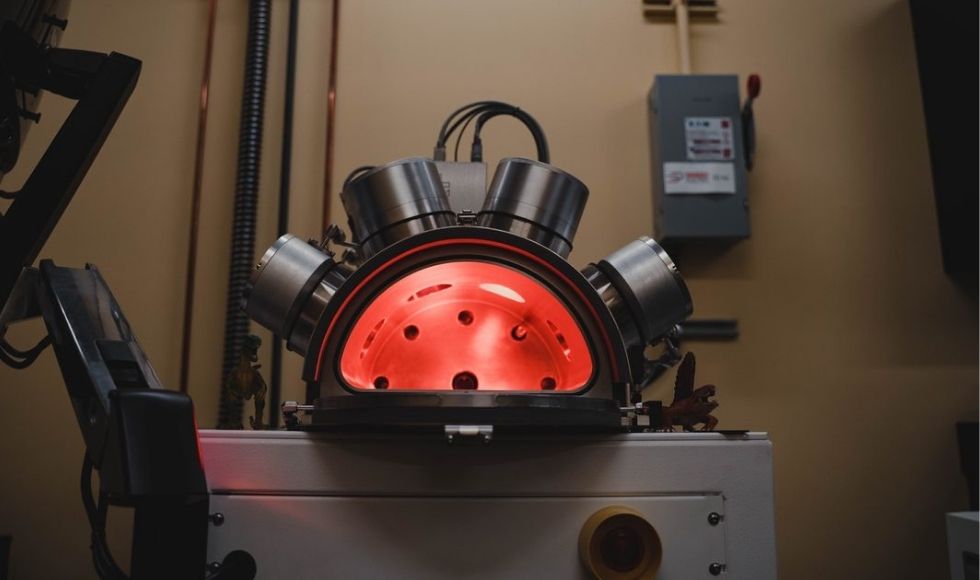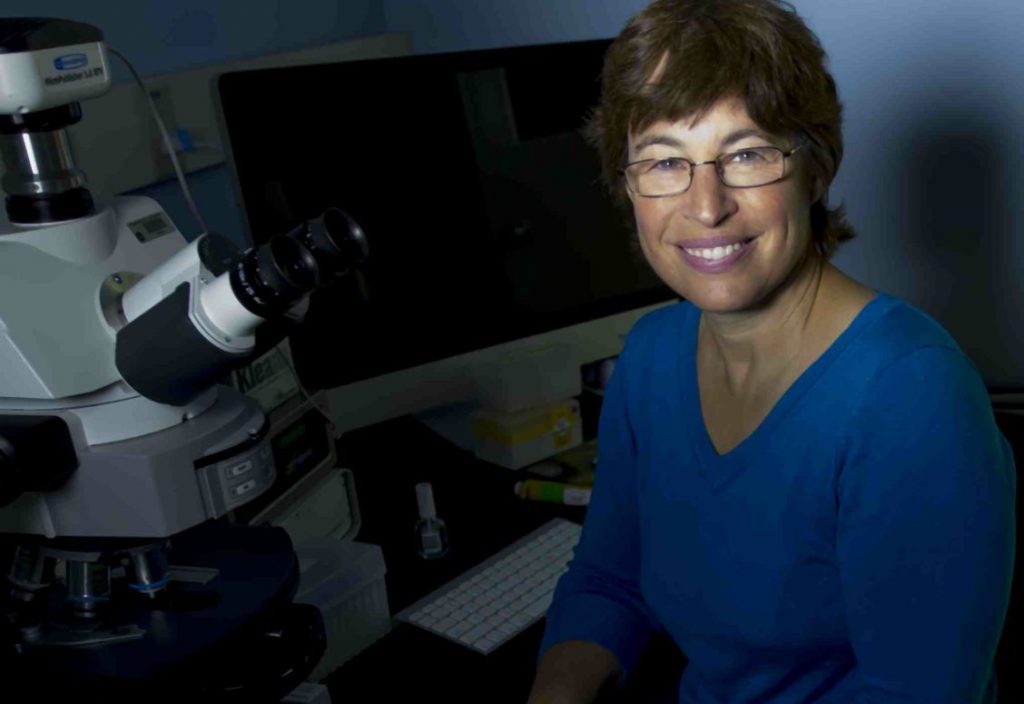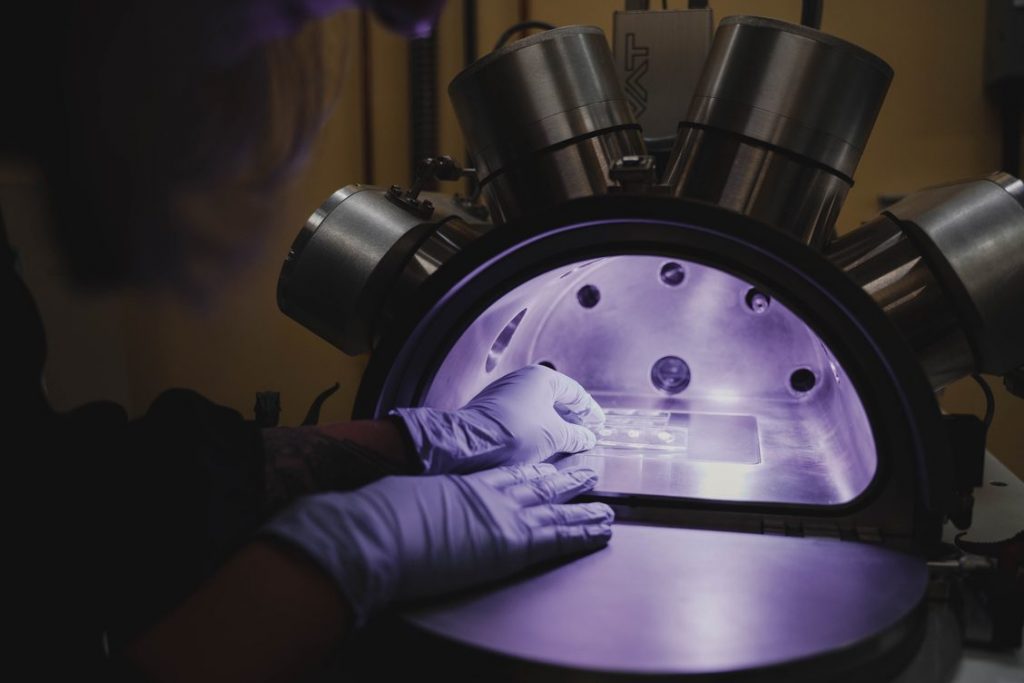McMaster researchers help plan the space habitat of the future

Roughly the size of a microwave, the planetary simulator at McMaster is a custom-built, one-of-a-kind, sophisticated scientific instrument that can recreate the environment on Mars in a box.
BY Kaleigh Rogers
November 16, 2021
On the morning of their second day on the moon, in December 1972, Apollo 17 astronauts Eugene Cernan and Harrison Schmitt awoke to the triumphant chords of Richard Wagner’s “Ride of the Valkyries.” The astronauts, the last two to ever visit the lunar surface, probably didn’t need such an energetic track to rouse themselves — turns out sleeping in a cramped lunar module isn’t the most comfortable. Apollo-era astronauts who had to attempt it in the ’60s and ’70s said light, noise, restricted space, and the excitement of what lay just beyond their bedroom window hindered a decent night’s snooze.
Before humans ever set foot on the moon, scientists and science fiction writers alike had all kinds of ideas for where astronauts would live, imagining lunar habitats from inflatable domes to igloos to train cars. But by the time we finally made it to the moon, the brevity of those visits and the technological challenges meant that the most practical option was to have the lunar module — the vehicle that astronauts used to descend to the surface of the moon — also serve as the habitat. It was a bit like RV camping: you sleep in the vehicle you drove to your destination.
Now, the next frontier of space exploration is on the horizon, with awe-inspiring plans to send manned missions back to the moon (including landing the first woman and first person of colour on the moon) and to Mars, as well as even more distant destinations possible down the line.
As space agencies and scientists prepare for this next chapter, the notion of a long-term habitat has been resurrected, with engineers and architects around the globe working on designs for where the next generation of explorers will work, eat, and (hopefully) sleep while away from Earth. And just like those early designs, the future of extraterrestrial habitat requires creative thinking that has led to some fantastical concepts.
Rather than tossing and turning on hammocks in the vehicle that brought them to the surface the way Apollo astronauts did, future space explorers may be cozying up inside 3D-printed pods insulated with Moon dust or houses made of mushrooms on Mars.
Apollo 17 marked the final and longest manned moon mission with Cernan and Schmitt staying on the surface for just over three days. The requirements of that trip were advanced and complex, to be sure, but the short duration meant the astronauts’ habitat didn’t require as much consideration: camping out in the lunar module for a long weekend was more than sufficient.
Still, space agencies and researchers had lots of ideas for long-term habitats, particularly on the moon. Designs in the 50s and 60s favored sending rockets laden with complete structures to be placed on the lunar surface and powered by nuclear reactors. By the 90s, the preference was toward lightweight, inflatable structures made of compostable material that would recycle water and convert carbon dioxide into oxygen.
But each of these designs was only theoretical. To find real world comparisons for long haul trips, you have to turn to space stations. Over the last 20 years, the International Space Station has been continuously occupied by humans, and along with the important scientific research onboard, it has served as a laboratory for off-Earth habitats.

“It was a lot more rigorous to live there in the beginning, a lot less comfortable and we slowly improved it over time,” said Colonel Jeremy Hansen, an astronaut with the Canadian Space Agency. “There have been improvements in the sleep quarters, in communications. The science facilities have changed on board, we’ve learned how to be more efficient with storage.”
Hansen has been deployed on missions here on Earth that simulate some of the extreme conditions in space, including NASA’s Extreme Environment Mission Operations (NEEMO), a research lab at the bottom of the ocean, and the European Space Agency’s Cooperative Adventure for Valuing and Exercising human behaviour and performance Skills program (CAVES), where astronauts live deep below the surface of the Earth in subterranean caves. Hansen said these simulations are great for troubleshooting prototypes and concepts for outer space habitats.
“One of the things I learned from NEEMO is there is real value in an iterative process,” Hansen said. “If you’re designing a habitat you’re going to live in for a long period of time, there’s a lot of value in building even a low-cost, low-fidelity mockup and just having people live in it to see if it actually works.”
There’s a lot of value in building even a low-cost low-fidelity mockup and just having people live in it to see if it actually works.
Currently, there are dozens of research projects on astronaut habitats, and many different concepts being tested out for all aspects of habitat design from material to systems. Lessons from previous missions and research provide a valuable wellspring of understanding to draw on, but the reality is we’ve yet to build a habitat on a body other than Earth, so there’s plenty of room for innovation — like having robots 3D print a giant egg made of Martian dirt.
NASA’s multi-year 3D printed habitat challenge tasked teams to design and build habitats suitable for deep space exploration. The winning design, from a firm in New York called AI SpaceFactory, would be made using Martian dirt and crushed rock mixed with a renewable bioplastic that can be extracted from plants. Shaped like a four-storey egg, the habitat would be constructed by robots sent to Mars ahead of astronauts, which would collect the materials, combine them, and 3D-print the structure using a telescoping arm. At the competition, the AI SpaceFactory team created a 1/3 scale prototype of the habitat, which would have four levels and be able to house a 4-person crew for up to two years. The team is now working with NASA to develop ideas for a 3D-printed lunar habitat.
Student teams have competed in NASA habitat design competitions, too, bringing forth imaginative new concepts. A team at California Polytechnic State University created a bug-inspired design for a habitat that would travel to the surface of Mars serving as part of the spacecraft, but then be detached and dropped to the surface ahead of astronauts. The habitat would start out as a compact canister, but once on the surface, would unravel, unfurling like a potato bug, with multiple wings expanding out to form a much more expansive and comfortable living environment.
If Martian rock eggs or coiled bugs aren’t your cup of tea, how about a house built out of mushrooms? Lynn Rothschild, an astrobiologist at NASA’s Ames Research Center, has been developing a concept to build space habitats using mycelia: the tiny, thread-like “root” system of a fungus. These delicate-looking threads are deceptively strong, and can be forced to form complex bindings when grown in a mold and given sufficient food (organic material such as grass clippings or wood chips). Once those formations are grown, they can be baked, hardening them into material as tough as leather or as sturdy as concrete.

Rothschild encountered the idea of mycelia as building material when a student of hers built a biodegradable drone out of the substance for a science competition.
“In theory, you could use it to build any shape and I thought ‘wouldn’t it be cool to build something on Mars?’” Rothschild said. “It was one of my 3,000 crazy thoughts before breakfast.”

Shortly after, she was having lunch with an architect colleague who was looking at mycelia as a building material and had the same crazy thought, so they joined forces to investigate just how crazy it was. They were awarded a grant through NASA’s Innovative Advanced Concepts program to study the basics like at what temperatures mycelium grow and how robust the resulting material is. Now, they’ve been given the funding to take it to the next phase and start building prototypes of the structures. And Rothschild knew exactly where she wanted to test out those prototypes: McMaster University’s Origins Institute. She had a longtime working relationship with the university, and had been itching to get access to one of the Institute’s most prized possessions, the planet simulator.
Roughly the size of a microwave, the planet simulator is a custom-built, one-of-a-kind, sophisticated scientific instrument that can recreate Mars in a box. With controls to adjust the temperature, humidity, pressure, radiation, and even the exact cocktail of gases found in the atmosphere, the simulator can recreate almost any planetary conditions imaginable and will allow Rothschild and her team to do a test run of how the mycelia habitats will fare on Mars and the moon.
“We will test the extreme conditions — high temperature, low temperature, high humidity, low humidity — and also the changes between day and night,” said Maikel Reinstadter, a McMaster biophysics professor and the lead investigator with the Origins Institute. “We want to find out what effect will these changing conditions have on the structure? Will it age quickly? Will cracks form? Will it swell on the inside and contract on the outside?”

The potential for mycelia as a building material is already established on Earth, but Rothschild thought it could be a clever way to meet a few of the challenges of designing a habitat in space. One major challenge is weight: it costs a lot of money to blast things off of the planet with a rocket, and construction materials can be notoriously heavy. Powdered mycelia, however, is incredibly lightweight, and can grow exponentially. Rather than lugging a habitat with them, astronauts could grow one after they arrive.
Another challenge is making inhospitable locales like the moon and Mars habitable for humans, and the fungi can help there, too. Rothschild’s habitat design would incorporate three layers: an outer layer of frozen water, a middle layer of cyanobacteria (the fungi’s food), and an inner layer of the mycelia. The cyanobacteria would live off of the water and sunlight (it can photosynthesize), feed the mycelia, and even produce oxygen.
Other researchers are focused on how to build deep space habitats that are not only functional, but also resilient. Shirley Dyke is a professor of mechanical engineering at Purdue University and runs the Resilient ExtraTerrestrial Habitats institute, a multidisciplinary research group exploring ideas to make habitats that can stand the test of time.
“You can build a habitat out of almost anything, but what we’re trying to focus on is the pros and cons of different options and what, overall, makes a habitat resilient?” said Dyke. “On Earth, we build buildings that can last 100 years. In many places, buildings are 500 years old. We’ve learned a lot on Earth about how to make these things sustainable for a long period of time.”
The research being done informs not only future space habitats but can help us build better dwellings on Earth, too.
Dyke’s institute collects all of the innovative ideas being proposed for space habitat from other researchers, and sees how they would actually function when combined, using scale models and computer simulations. It’s allowing them to build a catalog of the pros and cons of different habitat ideas and how different components interact, as well how they hold up to the unexpected like, say, an asteroid crashing into the roof. When you’re building a home in outer space, you have to consider every possibility.
Ultimately, Dyke said the next frontier of space exploration will likely see many different types of designs being used (not all houses on Earth are made the same way, she noted), and Rothschild agreed, adding that the research being done informs not only future space habitats but can help us build better dwellings on Earth, too.
To get to the future of space travel, we are learning from the past and harnessing the same creativity of our earliest dreams about life away from the surface. And that connection between past, present, and future is particularly suitable for the Origins Institute. Its planet simulator is typically used not for testing Martian habitats but for exploring ancient history: the conditions that led to the very first sparks of life on Earth.

When Ralph Pudritz, a McMaster astrophysicist and the founding director of the Origins Institute, was asked whether it was weird to go from looking so far into the past to suddenly testing out concepts for many years in the future, he challenged the question. For him, it’s all connected, and part of the most exciting scientific adventure humanity may ever endeavor. Pudritz explained that the conditions on early Mars were similar to Earth, making it just as likely as Earth to have life originate. By sending manned missions, which will require habitats like the one they’re testing, we may finally be able to determine whether there’s evidence of life on Mars.
It’s all connected, and part of the most exciting scientific adventure humanity may ever undertake.
“Mars is critically important to understanding the origins of life. If there’s evidence of life on Mars — a second incidence of life in the universe — that means there’s a higher probability of life elsewhere,” Pudritz said. “If Mars turns out to be negative, that will raise the question of whether life is really rare in the cosmos. These are big stakes issues.”
Cue the Wagner.
This article, part of a series of long reads exploring unique projects in the Faculty of Science, first appeared in a faculty newsletter.


